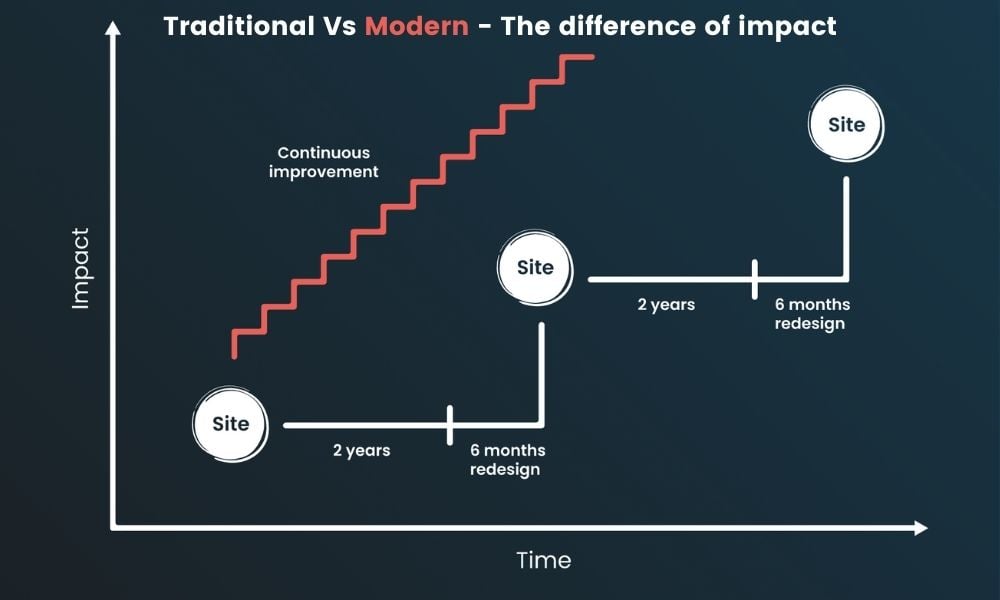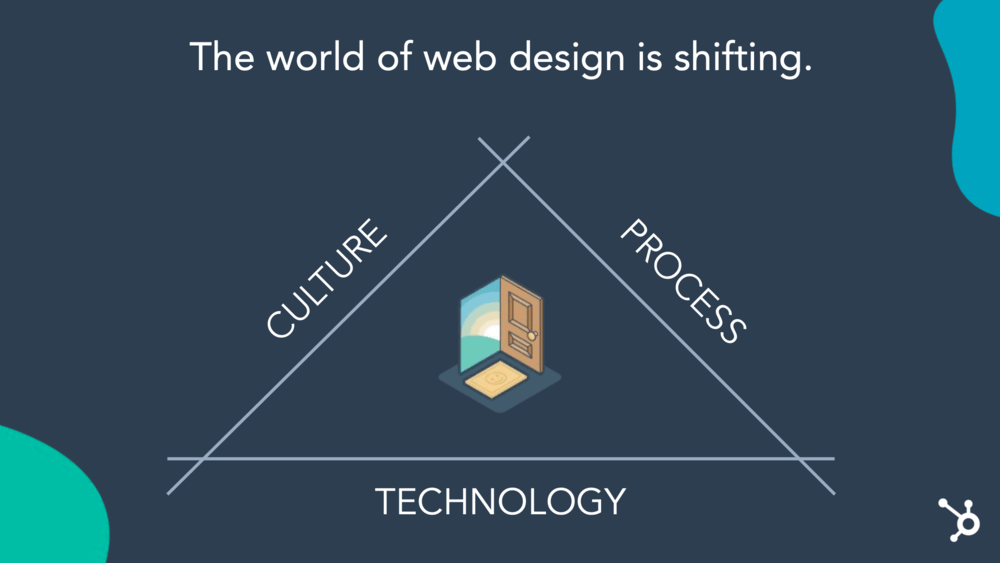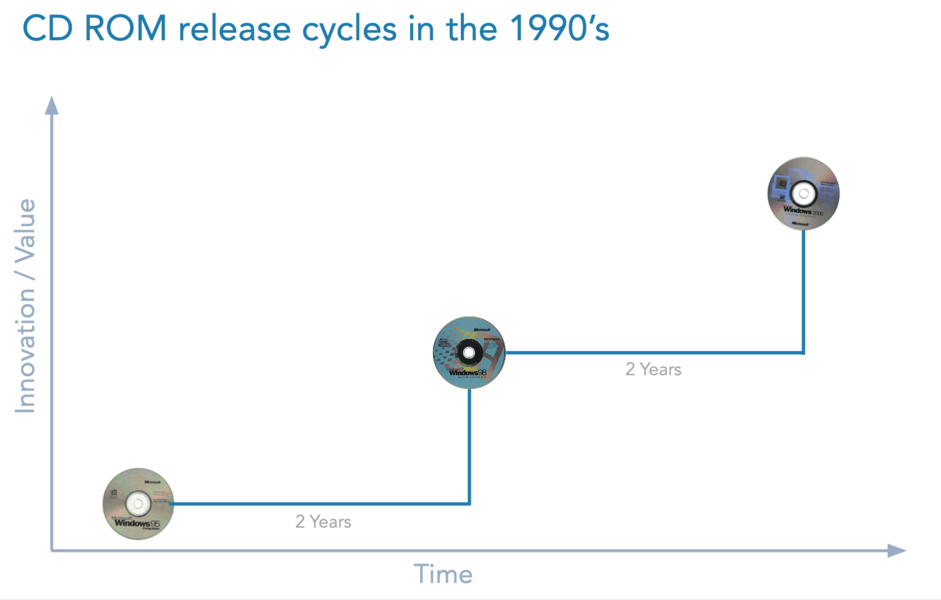On 5 May 2021, we hosted a webinar with Luke Summerfield. The Growth-Driven Design founder spoke about the 3 big shifts in the web industry as a whole, how modern companies treat their website as a product (not an expense) and the unnecessary headaches businesses no longer need to manage when creating and maintaining a website.
What the CD-Rom has to do with your next website redesign
According to Luke Summerfield, the paradigm shift in the web is not a new story. We’ve seen this same story play out in the world of software. Once upon a time, CD-Rom was the standard for delivering software in the ’90s. The crazy part was that software companies would only release these CD-Roms every 2 years.
Behind the scenes, there was a shift in culture, process, and technology in the software industry. The servers cost was going down, internet technology was getting faster, and the technology being used to build the software was getting better. This all worked together to cause a shift. How those software companies went about building the software. The shift from massive CD releases every couple of years to the SaaS model we see today and building peak performing software, where the product is always updating and improving.
These three shifts are happening in the world of the web design world. We’re seeing a shift in technology, process, and culture which is opening a door of opportunity for all of us to build our websites differently, around the customer experience that also delivers growth for our business.
To watch the full 1-hour talk by Luke Summerfield visit our on-demand webinar recording.
1. A shift in culture
Traditional web culture:
The headaches, challenges, and unreliable and inconsistent results we experience during a website redesign are the product of an outdated and broken playbook. With the traditional website culture, companies see their website as a business expense. It's seen as a sort of necessary evil that businesses have to do in the digital era, and it's seen as a one-time investment to get out of the way so that they can focus on other things.
HubSpot noted some risks to the traditional model, including:
- The time the initial launch takes
- Audience behavior changes over time
- New user demands throughout the process
Modern web culture:
What we see with high-growth companies is they think about their websites differently. The modern culture shift that's happened is towards a growth investment. Similar to any other investments, every single month you're thinking about how can we invest into our website and leverage that to generate better lead generation, better selling, better branding, and better relationships with our customers?
Now, that also means that we need to make a different shift from thinking about the website as a digital brochure and instead think about it as a product with a wide-sweeping impact.
There are so many more impactful ways to leverage your website to grow your SaaS business. You can expand into other departments.
- How might we leverage the website for new customer onboarding for our team?
- How might we leverage the website to decrease the number of support tickets to take the load off of our support team?
- How might we leverage the website for new hire training every time you hire a new employee?
- Can we build an onboarding experience for those employees on the website? Can we leverage the website for HR and recruiting?
The other way you can expand is through the customer journey. You have more data at your fingertips than ever before and you can leverage tools, like HubSpot that help you make better, more informed decisions to tailor their experiences.

2. A Shift in process
A traditional approach to web design
Take a moment to think back to your last website build or redesign. Did you just roll your eyes and shudder at the horrific memories of that painful experience? Well, you are not alone. Although there are some positive aspects to it, the traditional website design process is flawed.
A traditional approach to website design often comes with a lot of risks, goes over the scope and over budget, and is often delivered late. However, the biggest issue by far is the fact that you are essentially launching your website with no idea of whether it's going to go down well with your audience because the site performance is a complete hypothesis.
As a marketing and web design agency, we see businesses struggle with this problem all the time. They’ll allocate a huge budget to a new site, set it live, and forget about it. Regardless of how fantastic your design was, it’s inevitable that elements will become irrelevant and stop producing the results you're after. This is why ongoing analysis and maintenance are critical to having a consistently high-performing website.
A modern approach to web design
As inbound marketers, everything we do revolves around attracting our targeted buyer persona, so to build an entire website–the storefront of your business–without really knowing what your buyer wants is just poor form. The basis of inbound marketing is in-depth research into your buyer's problems, goals, aims, and desires, so when you are producing content, you can tailor it to fulfill their goals and offer solutions to their problems. This background research is also the first step in this new design approach, built by inbound marketers to produce a website that is reflective of what your buyer wants and evolves to keep up with their changing behaviors.
This new process that was founded by Luke Summerfield, is Growth-Driven Design (GDD).

3. A shift in technology
Are traditional CMSs broken?
A shift in website culture and process should inform how we think about technology. Controlling your content is an integral part of managing your marketing efforts. A CMS gives you the ability to create, update, and change your content at a moment's notice.
As your business website gets more complex, you end up inevitably having gatekeepers where the developer and IT team have to get involved for every little update and edit which slows the process down. Other bottlenecks you will face using a traditional CMS include:
- Tough to create a site that's responsive
- Do not always scale well
- Requires developers who are CMS specific
- Limited flexibility
- More time and money are required for maintenance and enhancements
This approach is not efficient for booming companies and will limit your ability to generate results quickly.
Read more about how HubSpot's CMS Hub can help you grow your business here.
HubSpot: A modern CMS
Working on a traditional CMS can be a real pain. Countless plugins, server configurations, updates, and the constant threat of being hacked are enough to give anyone a persistent headache.
HubSpot CMS Hub is a powerful software as a service (SaaS) CMS that offers speed, security, and scalability while taking away the stress of CMS management.
A SaaS CMS is software that exists in the cloud and allows you and your team to log in and operate from anywhere. Remote workers rejoice! What’s great about a SaaS CMS is that the vendor, which is HubSpot in this case, maintains the software, handles hosting, and deals with your support queries all for a monthly or yearly fee.
HubSpot's CMS is a system that is a combined tool incorporating CMS and CRM in one platform and automatically captures your visitor's data. It enables the personalization of the entire customer journey and creates better user experiences from the first visit onwards.
Visitors to your website are not static, so as your relationship grows and changes, your website should too.
If you’re ready to update your business website, get in touch. We'll work alongside your team to turn your ideas into a growth-driven reality.
